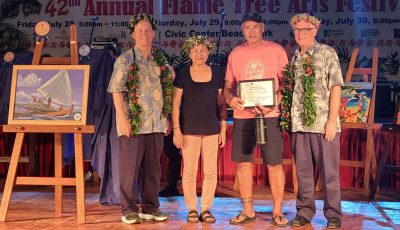3rd-party review of military plans eyed
The federal agency guiding historic preservation across the nation has confirmed a possible third-party and expert review of U.S. military undertakings in the CNMI, as the two different and separate projects the U.S. Department of Defense has pushed in recent years could compromise the integrity of Saipan and Tinian’s historical landmarks.
The Advisory Council for Historic Preservation initiates this review by requesting the Department of the Interior to task the National Park Service to analyze the military impact to historical sites.
That review is called Section 213 Report, prepared under Section 106 of the National Historic Preservation Act.
“We are still actively considering the request of a Section 213 Report for undertakings within the CNMI,” confirmed Katharine Kerr, ACHP Federal Property Management Section program analyst, on Friday.
The preservation council says Section 213 Reports have been sought for undertakings involving national historical landmarks in which consultation was “particularly difficult and/or controversial.” The 213 Reports are intended to provide useful, independent, and authoritative information to consulting parties.
Saipan Tribune learned there has been a push from within local consulting parties to urge the council to initiate this report. As there are two major historical landmarks on Saipan and Tinian, all the cumulative effects—from the military’s separate live-fire project, to the divert airfield project—must be considered.
“Yes, I wholeheartedly endorse this third-party and independent review,” said Rep. Angel Demapan (R-Saipan), chairman of the House Committee on Federal and Foreign Affairs, when sought for comment. “I also urge my colleagues to throw their support behind this effort as it seeks to serve the best interest of the Commonwealth.
“The divert and [CNMI Joint Military Training live-fire] projects have since triggered the attention of both Commonwealth officials and more importantly, residents of Saipan and Tinian. Moreover, because of the magnitude of these proposed projects, there are a myriad of concerns from cross sectors of our community.
“One significant issue centers on the potential impacts the projects may have upon areas on Saipan and Tinian that have long been designated as National Historic Landmarks.
“The CNMI is currently in a complicated and separate Section 106 consultations with divert and CJMT, and the cumulative effects should be considered.
“A Section 213 Report will accomplish this and is necessary because the Marines and the Air Force continue to separate the two projects,” Demapan said.
The Air Force has determined that their proposed action would have no direct adverse effect or contributing elements to the Aslito/Isley Field, on the Saipan Landing Beaches [a National Historical Landmark], Aslito/Isley Field, Marpi Point National Historic Landmark, or other historic properties on Saipan, according U.S. Air Force Col. Michael R. Cardoza in a letter of findings to historic impact in August.
“However, the USAF finds that certain proposed actions in the various alternatives could have an adverse effect on the American Administration-period West Field site on Tinian and possible indirect adverse effect on the setting and feeling of the Aslito/Isley Field National Historic District on Saipan,” Cardoza writes in the August letter.
For the CJMT project, CNMI officials have said the Tinian registered historical national landmark will be adversely impacted by the operation of the proposed firing ranges. The U.S. military’s plan to build ramps for amphibious assault vehicles at Unai Chulu Beach have been found troubling as Unai Chulu is part of the North Field and Landing Beaches Historic National Landmark. CNMI officials have earlier discouraged the degradation of this important landmark or the environment found there.
A Section 213 Report could address the “cumulative” impact of these two Air Force and Department of Navy projects.
Analysis of “cumulative” effects has been found lacking by many administration and government officials and consultants reviewing Defense impact documents.
ACHP says the National Park Service, through the report, would share its expert opinions on the significance of a historic property, the effects of the proposed undertaking on the property, and the recommendation of measures to avoid, minimize, or mitigate adverse effects to the property.
The report can be used as a tool in the Section 106 consultation and is made public record.



























